
CHART
BOX
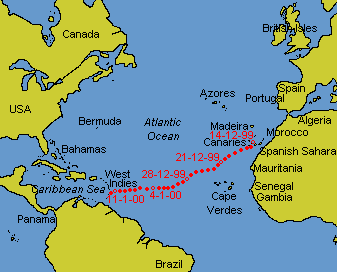
© Copyright 1999-2000 Nigel Jones/MistWeb Software

In keeping with the wind, described on the previous page, the seas were rough for much of this crossing. We keep a journal as well as a log. Here is what I wrote during the crossing:
 | CHART |
 | |
| Sketch Maps and Chartlets (not to be used for navigation!) © Copyright 1999-2000 Nigel Jones/MistWeb Software | |
It's rough again today. It's not always rough like this - sometimes life aboard is quite placid but today every move you make is controlled by the sea's movement.
Last night we had squalls again. We saw 35 knots of wind sustained for several minutes while we were hammered by heavy rain. We watched the big, black blob creep across us, huddled together around the radar screen at 3 a.m.
The wind is down to its usual 20 knots again now but not the sea. There are waves of every size from about 1 metre to about 10 metres all heaped and piled and sliding through and over and under each other. About half of the time, if you watch, you can see holes or humps about the size of two-storey houses coming at the stern. Sometimes they are narrow, only two or three houses wide, sometimes whole terraces of them approach at once. Sometimes holes the size of terraces open up behind for us to slip into.
If you're fairly quick scanning the 360° horizon you usually don't get wet standing on the companionway steps with the washboards firmly locked in place and the sliding hatch open. It takes some will-power to turn your back on the approaching hooligans and scan the horizon in front of the bow.
As the tops of the waves break they make spine-tingling roars and hisses that race past the boat at tremendous speeds.
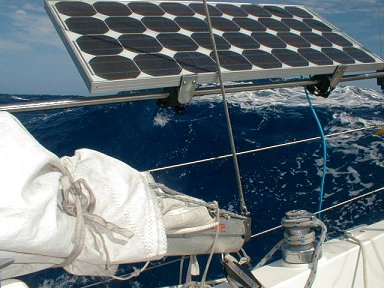 |
| One of the steeper seas rears up under Rusalka Mist's quarter. If it breaks now we are going to get soaked - again. The solar panels and their home-designed mounts survived any number of these breaking seas admirably. Click here for details of these panels and their mounting. |
Sometimes, of course, one breaks very near the stern but, as I'm told is true of passing bullets in trench warfare, you don't hear a thing from the one that gets you.
Every five or ten minutes we get a bucket-full of water thrown over some part of the boat by a wave that breaks very close.
But about once an hour we get a truck-load of water hurled at the boat which half fills the cockpit and streams down all the cabin windows at once. This is the one which broke right on top of us. There is no warning. You feel the boat lurch forwards or sideways as if kicked by the rubber sea-boot of King Neptune himself. Simultaneously is a thick "Tch" sound as all the water hits together then there is the "Psssccchhh" as it cascades and pours down the cabin, the decks and the cockpit.
If you're quick you can look out in the sudden calm that invariably follows this huge expenditure of energy. You see little silver fish quivering and jumping in the sloshing deluges all trying, along with the water itself, to get back into the normality of the pure, empty ocean.
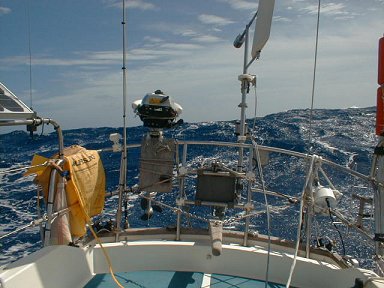 |
| This is one of the thousands of seas that passed harmlessly under our stern. It is amazing, if they are not breaking, how a good hull form can ride over these seas. |
We did not see as much wildlife in the open Atlantic as we had in Biscay (Bay of Biscay: Page 2, Page 3, Page 4 and Page 5 all refer to wildlife adventures during that voyage). But then we did not spend so much time sitting around in the cockpit watching the world go by in this crossing either!
The first thing we saw were large flying fish. There seem to be two sizes of flying fish out there: the large ones are about 8 inches (100 mm) long and the smaller ones are 3 inches long (75 mm). They may be adults and juveniles of the same species, but we saw none at any size in between so we are tempted to think they are not.
At 0730 on the 21st December 1999 at 22° 29' N and 25° 44' W I wrote, "A little squadron of about eight flying fish just took off and flew to windward, 10 metres (30 feet) to port, only flying for a few meters. None on deck." That was the first we saw of them. Later they became quite a common sight, often flying much greater distances and in any direction, showing such great ability in the air that we could easily have mistaken them for birds except for their abrupt, total and final disappearance at the end of each flight.
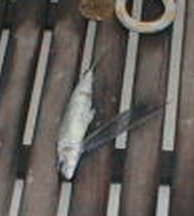 |
| This Atlantic flying fish is not looking or feeling its best, after a night on the cockpit floor but it is displaying one of its fin-wings for us all to see. |
They use their greatly extended fins for wings. Most fish have two fins either side of their body right behind their head, extending downwards and out to left and right. In flying fish it is these two fins which have each grown to about the length of their body and which get extended as wings into the air when they have leaped out of the side of a wave. Their body is very strong and muscular and they can clearly control their flight to a height of a few metres and for flights of maybe up to 10 seconds at a time.
The last thing they expect in their pristine ocean, especially at night, is a fibreglass yacht to be passing where for the whole of the rest of their lives there has been nothing. They often crash-landed on deck or into the cockpit. They flopped and banged around considerably, and those free of the deep cockpit walls often made it back into the water. There was often at least one in the cockpit by morning however. I have heard of ocean yachtsmen collecting them from around the deck each morning to fry up for their breakfast. I can only assume that this is during much calmer crossings than ours and involving yachtsmen with much sterner stomachs than ours too.
I wonder if fish eyes work any better in air than human eyes do without goggles under water? One thing I did notice, especially in the case of the smaller variety of flying fish is that their head is formed differently to the average fish so as to allow their eyes to look forward. This gives them something of the disturbing look of an owl if you try to return their glazed stare at 0700, before throwing the tiny corpse back to the deep.
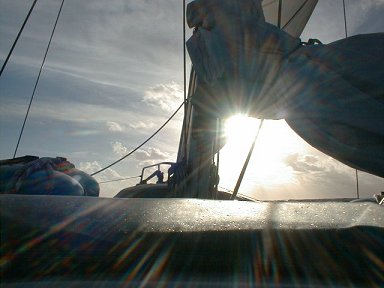 |
| Nothing much happened, but day after day we were treated to beautiful sunrises, sunsets and billions of night-time stars |
The second one appeared just before noon on the 7th January 2000 at 13° 51' N, 52° 08' W. I wrote: "Visited by our second inquisitive whale. This one had no generator turbine to sniff, but you could see him inside the transparent waves." That much further along our journey the water had become incredibly clear, as it is here in the Caribbean. Waves which heaped up against the sunlight often became quite transparent for a split second as light was refracted right through the great mass of water. It was spectacular to see the large black bulk of the whale, similar if not identical in species with the first, clearly revealed in the heaving folds of water around the boat as he accompanied us and explored our hull.
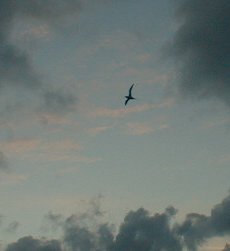 |
| These birds were solitary, and appeared to have a piece of string for a tail. They were inquisative about us and the boat and followed us for minutes on end when one found us in mid-ocean. |
We were surprised that there seemed to be no point on our crossing that was too far from land for birds to venture. We saw two species: one was a small bird that seemed quite common right across the ocean. We saw them perhaps every other or third day throughout the central part of the crossing. They were the size of pigeons, black with a white collar. We could only assume from their size and low-flying habit that they were living off the smaller flying fish and slept either on the water or, somehow, on the wing. They were not interested in us at all.
The second species was a larger bird, larger than a herring gull, perhaps the size of a black-backed gull. It was white and was characterised by having, for all the world what looked like a short piece of string trailing behind instead of tail feathers. This was a solitary bird and we were visited three or four times in the latter weeks of the crossing. They seemed very interested in the boat and flew with us, matching our speed, first one side of the mast and then the other for minutes on end. We wondered if they might want to land and catch a ride or a rest, but they never did.
Another boat with whom we were in short-wave radio contact for most of the trip was much luckier. They were a New Zealand boat heading south for Cape Town, South Africa. As they skirted the Brazilian coast near the equator a large egret found them and soon landed on board. It was so exhausted and so grateful for the dry touch-down that all normal fears and timidity were apparently put to one side and it came below and shared the cabin with the humans for at least one night. The skipper said it made little mess and, considering the dire alternatives for the unfortunate bird, he was quite happy to clear up after it!
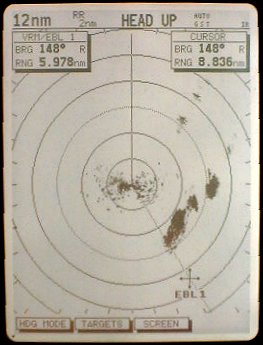 |
| The radar was very useful, not only in helping with collision avoidance with shipping, but in tracking and assessing the risk of squalls. Here you can see a group of squalls which may just miss us. The diagonal line labelled 'EBL 1' shows the current apparent wind angle. The range rings are 2 nm apart so the squall on the EBL is about 5 nm away. |
We kept up a 24-hour watch for shipping throughout the crossing and we saw only about half a dozen ships in the whole 29 days at sea.
We were very glad that we did, however as two of those ships had to be persuaded to alter course so as to pass us safely. This was in each case easily negotiated on Channel 16 of the VHF radio.
"Hello, the ship near 16° 56' North, 36° 46' West, this is the yacht Mike-Kilo-Kilo-Zulu-Six, Mike-Kilo-Kilo-Zulu-Six. Do you copy, over." I use our call-sign because 'Rusalka Mist' is such a mouthful to spell out in a potential emergency.
"Yacht Mike-Kilo-Kilo-Zulu-Six, this is the bulk freighter Star Conveyor, my position is 16° 57' North, 36° 49' West. Ummm, go ahead, over."
"Star Conveyor, good evening, sir. We are four miles away on your port bow. I have you on radar and visual. It appears that we are going to pass very close, do you see us?"
"Ahhh, yes. I see your light now. Please, what is your course and speed?"
"We are making 4.2 knots on 280 magnetic. We are under sail and it is very difficult for us to alter our course or speed, over." It is always best to try not to have to mess with things in the dark. As a sailing boat we do have right of way, although of course I could easily turn by up to 90° either way and slow right down by rolling up the jib. He only has to type a number into a keypad in the nice air-conditioned bridge.
"Roger, got that. We shall alter course to port to pass behind you."
"Roger, thank you, sir. Have a good watch and a good trip. This is yacht Mike-Kilo-Kilo-Zulu-Six, standing by."
"Err. Yes, a good trip for you also. Goodnight."
The second ship, on nearly the last night of our crossing, was on a reciprocal course with us and turned first to his left then to his right. This confusingly put us extremely close before he straightened up to pass a few hundred meters (or yards) down our port side. After seeing nothing much but empty ocean for four weeks this felt like an extremely close pass to us. His black bulk in the night blotted out a good third of our sea horizon when he was alongside.
There's not much out there to hit, but that's what the other skipper is thinking too. A good look-out, day and night, is unfortunately imperative as you only need to miss one of these and it could be very, very dangerous. Even single-handed, I do not think you should sleep for more than 15 to 20 minutes, even in the deep ocean these days. This is a great shame, but a fact of our times I fear.